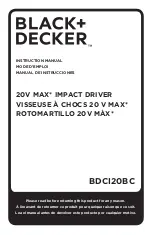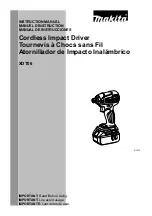
NOTE:
• The battery charger is for charging Makita-battery
cartridge. Never use it for other purposes or for
other manufacturer’s batteries.
• When you charge a new battery cartridge or a
battery cartridge which has not been used for a long
period of time, it may not accept a full charge. This
is a normal condition and does not indicate a
problem. You can recharge the battery cartridge
fully after discharging it completely and recharging a
couple of times.
• If you charge a battery cartridge from a just-
operated tool or battery cartridge which has been
left in a location exposed to direct sunlight for a long
time, the charging light may flash in red color. If this
occurs, wait for a while. Charging will begin after the
battery cartridge is cooled by the cooling fan
installed in the charger. When the temperature on
battery is more than approx. 70°C, two charging
lights may flash in red color, and when approx.
50°C – 70°C, one charging light in red color.
• If the charging light flashes alternately in green and
red color, charging is not possible. The terminals on
the charger or battery cartridge are clogged with
dust or the battery cartridge is worn out or dam-
aged.
Cooling system
• This charger is equipped with cooling fan for heated
battery in order to enable the battery to prove its
own performance. Sound of cooling air comes out
during cooling, which means no trouble on the
charger.
• Yellow light will flash for warning in the following
cases.
– Trouble on cooling fan
– Incomplete cool down of battery, such as, being
clogged with dust
The battery can be charged in spite of the yellow
warning light. But the charging time will be longer
than usual in this case.
Check the sound of cooling fan, vent on the charger
and battery, which can be sometime clogged with
dust.
• The cooling system is in order although no sound of
cooling fan comes out, if the yellow warning light will
not flash.
• Always keep clean the vent on charger and battery
for cooling.
• The products should be sent to repair or mainte-
nance, if the yellow warning light will frequently
flash.
Conditioning charge
Conditioning charge can extend the life of battery by
automatically searching the optimum charging condi-
tion for the batteries in every situation.
The battery employed in the following conditions
repeatedly, will be worn out shortly, and yellow warn-
ing light may flash.
1. Recharge of battery with its high temperature
2. Recharge of battery with its low temperature
3. Recharge of full charged battery
4. Over-discharge of battery (continue to discharge
battery in spite of down of power.)
5. Recharge under broken cooling system
The charging time of such battery is longer than
usual.
Trickle charge (Maintenance charge)
If you leave the battery cartridge in the charger to
prevent spontaneous discharging after full charge,
the charger will switch into its ‘‘trickle charge (main-
tenance charge)’’ mode and keep the battery car-
tridge fresh and fully charged.
Tips for maintaining maximum battery life
1. Charge the battery cartridge before completely
discharged.
Always stop tool operation and charge the battery
cartridge when you notice less tool power.
2. Never recharge a fully charged battery cartridge.
Overcharging shortens the battery service life.
3. Charge the battery cartridge with room tempera-
ture at 10°C – 40°C (50°F – 104°F).
Let a hot battery cartridge cool down by inserting
it into the charger.
4. Charge the Nickel Metal Hydride battery cartridge
when you do not use it for more than six months.
Selecting correct socket
Always use the correct size socket for bolts and nuts.
An incorrect size socket will result in inaccurate and
inconsistent fastening torque and/or damage to the
bolt or nut.
Installing or removing socket (Fig. 3 & 4)
CAUTION:
Always be sure that the tool is switched off and the
battery cartridge is removed before installing or
removing the socket.
1. For socket without O-ring and pin
To install the socket, push it onto the anvil of the
tool until it locks into place.
To remove the socket, simply pull it off.
2. For socket with O-ring and pin
Move the O-ring out of the groove in the socket
and remove the pin from the socket. Fit the socket
onto the anvil of the tool so that the hole in the
socket is aligned with the hole in the anvil. Insert
the pin through the hole in the socket and anvil.
Then return the O-ring to the original position in
the socket groove to retain the pin. To remove the
socket, follow the installation procedures in
reverse.
6
BTW120 (Eng) (’100. 11. 28)
Содержание BTW120
Страница 2: ...1 2 3 4 5 2 1 3 4 6 5 3 7 8 10 7 9 11 6 12 13 15 16 14 12 2 ...
Страница 69: ...69 ...
Страница 70: ...70 ...
Страница 71: ...71 ...
Страница 72: ...72 ...
Страница 73: ...73 ...
Страница 74: ...74 ...
Страница 75: ...75 ...
Страница 76: ...Makita Corporation Anjo Aichi Japan Made in Japan 884377 996 ...







































